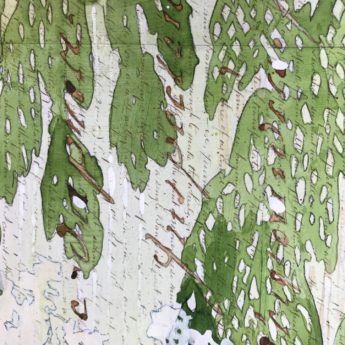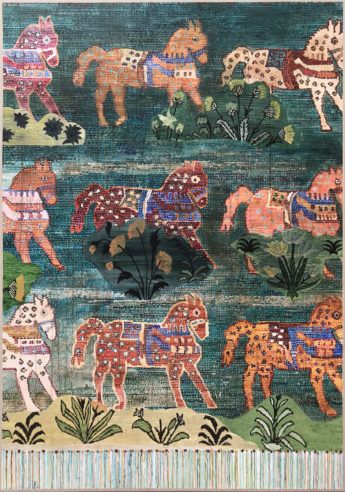I met Renee Bott many years ago when I started preparing and editing interviews for Paulson Bott Press (now Paulson Fontaine Press). Renee retired from the press a few years ago and began focusing on her own artwork. On College Avenue, not far from Renee’s home, is Moss Gallery, a pop-up gallery curated by Stacey Moss. Renee and I walked over to look at the group show, which included some of her recent work.
Kenneth Caldwell: Where did you begin when you started making art again?
Renee Bott: Initially I started making paintings and collages with book pages.
I would dismantle the book. In this case, all the text that you see in these two pieces was taken from the complete work of Edgar Allan Poe. It’s not like Poe is my favorite writer. The choice was based on the quality of paper, to be honest. The book pages were cut out of the book, and the margins were cut off so that I could get the text to run together.
Q: Continuously?
A: Yes, continuously. This one is called Words Falling Like Rain. The text is mounted perpendicularly. In selected areas I painted over the text with different whites, reds and blues concealing the text with lines of color. I then painted the weeping willow tendrils over the concealed text and the lined-up portions to create a feeling of a veil. The one above it is called Poe’s Ocean.

Poe’s Ocean, 2020. Artist: Renee Bott.
Q: So where did you get the form for the ocean and the form for the willows?
A: Those are based on old engravings or etchings. The ocean is taken from a giant etching that hangs at the Achenbach [Foundation for Graphic Arts at the de Young Museum]. I’ve used that water image before, it’s a vast battleship scene.
Q: So how did you get the image onto the book?
A: All of these are done pretty much the same way. I take a photograph of the etching, then I edit it in Photoshop. I blow it up and look at different portions of it to see what interests me. Then I print it out and use it as a guide, basically tracing it.
Q: How do you trace it?
A: I put it right on top of the book pages and then outline it and paint.
Q: When you say outline, do you go over it with a pencil?
A: Yes, I use carbon paper. That’s how all of these are made. It’s about taking one thing out of context and changing it into this new medium.
There is a problem with just taking an image from an etching and blowing it up and putting it on top of text. You need to take it further to invite the viewer to wonder a little bit.
Q: Tell me about this piece.
A: I started thinking about the text of a book and then thinking about how we read books; turning pages has been outdated, and people are reading more and more online. Then I started thinking about handwriting and how we used to write letters to each other. This is French handwriting on top of another beautifully handwritten letter that is mostly whited out. If you look carefully, you can see it in areas. You see the handwriting?

Words I Should Have Said, 36×70. Artist: Renee Bott.

Words I Should Have Said. Detail of handwriting behind image. Artist: Renee Bott.

Words I Should Have Said. Detail of handwriting behind image. Artist: Renee Bott.
Q: Yes.
A: I was thinking about how we don’t read books anymore and we don’t write letters anymore. Everything’s digital. So I was sort of playing with handwriting and book pages as this sort of lost art. The images are derived from an old engraving as well. So my work is based on media that has gone by the wayside.
Q: And where did the French letter come from?
A: I took photographs of several old letters. I particularly liked the handwriting in this one. It’s very floral. And it has all these accents and loop-de-loops. It was written with a quill or an old quill tip. So it’s Xerox paper on top of canvas.
Q: And then you painted over that?
A: Yes, exactly. In Photoshop, I cobbled together different images of trees from various etchings. Then I superimposed the image of the handwriting on top of the foliage. I sized it in Photoshop, printed it out, and used that as my guide.
This one is called Everyday Thought.
Q: With the flowers?
A: It is a painting on graph paper. I if you look carefully, you can see that there’s a dot of color for every square in the graph paper. I wanted it to look like an old, faded prayer rug, an idea which directly relates to the loss of my husband Scott. I was thinking about the act of saying a prayer every day. I envy people who can sit down on a prayer rug and pray. I’m not religious. So I was paying homage to that idea.

Every Day Thoughts. Artist: Renee Bott
Q: And that was made in the same way as these other pieces?
A: I found the rug image on a website and blew it up. The colors don’t look anything like that. I played with the color to see how it would work. Then, searching online for rugs to use, I found a horse rug that I really liked. So these next two are related to the horse rug.
I liked the horses so much I wanted to do them bigger. And I thought I could really capture the feeling of a worn rug. Then I superimposed these plant images onto it.
Why just replicate the rug? You can just have the rug. I wanted the flowers to be sort of like the prayers that you would have while you’re on the rug.
This one’s called Everyday Thought. This one’s called Enlightenment. These paintings are contemplations about prayer, or sitting quietly on a beautiful rug and thinking. Hopefully after thinking, one is enlightened. The larger one is called Enlightened by Poe because you can see pages of Poe at the bottom.
An interesting thing about creating images is you just have no idea what they’re going to look like. You just don’t know until you’re done. And then when they’re done, you’re surprised.

Enlightenment, 40 x 30, 2020. Artist: Renee Bott.

Enlightened by Poe, 2020. Artist: Renee Bott.
Q: So you don’t start out with a preconceived idea?
A: You do, but you still don’t know what it’s going to look like. That’s the weird thing about making art. There are times when you get really excited about something—“Oh, this is going to be great.” And then you finish it, and it’s like, “That didn’t really work.” Or vice versa. You think, “This is a disaster. It’s not going to work.” And then you finish, and you go, “Wow, that works.” But you have to finish it in order to know. So sometimes you put a lot of time into something, and you’re thinking, “What am I doing this for?”
Q: What do you do if you decide it’s not right?
A: In this case, with the canvas, I just paper over it and begin again.
Q: In your work, what’s a commission look like?
A: For a commission I recently completed the client liked the idea of the willow tree. I have done several images of the weeping willow. She liked what it represented: time. The willow provided a great hiding place for me as a child, a beautiful lacy house where I would go to tell myself stories like, I’m going to bring my boyfriend to this beautiful spot under the willow tree, and kiss him. And then one day you are under the tree kissing your boyfriend. And then the next thing you know, he’s gone.
The weeping willow has become a symbol of love and romance for me. So I made her this piece called Willow Words. The willow tree is, pretty literal. But then there are ribbons of text that run down the long tendrils of leaves—it sort of looks camouflaged in there, but you can see they go over the arm of the tree.

Willow Words, 40×30, 2020. Artist: Renee Bott
Q: What is that text?
A: The book pages are from a random fiction book. And I picked it because of the quality of the paper. For example, pulp fiction is just going to yellow because it’s not archival. Now when I pick books, I’m looking for archival paper so that it won’t yellow and change dramatically.
I used to think about the content of the book applying to the image, but I don’t do that anymore. I just don’t think it’s that important.
I let people bring their own context to that.
Q: So what else are you working on?
A: I am trying to resolve this prayer rug/enlightenment idea. I feel like COVID and this time of political unrest have created a lot of time to sit around and think. And also, with the loss of Scott, I find myself wondering, what am I doing here? What’s my purpose? I feel like I have to get beyond being so literal in my thinking about these things. That’s where I’m trying to go.
I feel like my artwork is better if I’m working on a problem instead of just trying to make an attractive image. The images have to come from a very personal place. People don’t necessarily need to know what they are in order for them to work. But I feel like I have to think about that first.
